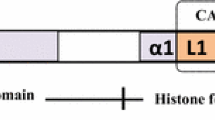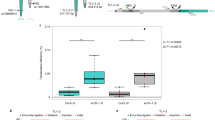Abstract
Arabidopsis thaliana has emerged in recent years as a leading model for understanding the structure and function of higher eukaryotic centromeres. Arabidopsis centromeres, like those of virtually all higher eukaryotes, encompass large DNA domains consisting of a complex combination of unique, dispersed middle repetitive and highly repetitive DNA. For this reason, they have required creative analysis using molecular, genetic, cytological and genomic techniques. This synergy of approaches, reinforced by rapid progress in understanding how proteins interact with the centromere DNA to form a complete functional unit, has made Arabidopsis one the best understood centromere systems. Yet major problems remain to be solved: gaining a complete structural definition of the centromere has been surprisingly difficult, and developing synthetic mini-chromosomes in plants has been even more challenging.
Similar content being viewed by others
References
Brandes A, Thompson H, Dean C, Heslop‐Harrison JS (1997) Multiple repetitive DNA sequences in the paracentromeric regions of Arabidopsis thaliana L. Chrom Res 5: 238‐246.
Carbon J, Clarke L (1990) Centromere structure and function in budding and fission yeasts. New Biol 2: 10‐19.
Copenhaver GP, Pikaard CS (1996) RFLP and physical mapping with an rDNA‐specific endonuclease reveals that nucleolus organizer regions of Arabidopsis thaliana adjoin the telomeres on chromosomes 2 and 4. Plant J 9: 259‐272.
Copenhaver GP, Browne WE, Preuss D (1998) Assaying genome‐wide recombination and centromere functions with Arabidopsis tetrads. Proc Natl Acad Sci USA 95: 247‐252.
Copenhaver GP, Nickel K, Kuromori T et al. (1999) Genetic definition and sequence analysis of Arabidopsis centromeres. Science 286: 2468‐2474.
Copenahver GP, Keith KC, Preuss D (2000) Tetrad analysis in higher plants. A budding technology. Plant Phys 124: 7‐15.
du Sart D, Cancilla MR, Earle E et al. (1997) A functional neo‐centromere formed through activation of a latent human centromere and consisting of non‐alpha‐satellite DNA. Nature Gen 16: 144‐153.
Fransz PF, Alonso‐Blanco C, Liharska TB, Peeters AJM, Zabel P, de Jong JH (1996) High‐resolution physical mapping in Arabidopsis thaliana and tomato by fluorescence in situ hybridization to extended DNA fibers. Plant J 9: 421‐430.
Fransz P, Armstrong S, Alonso‐Blanco C, Fischer TC, Torres‐Ruiz RA, Jones G (1998) Cytogenetics for the model system Arabidopsis thaliana. Plant J 13: 867‐876.
Fransz PF, Armstrong S, de Jong JH et al. (2000) Integrated cytogenetic map of chromosome arm 4 S of A. thaliana: structural organization of heterochromatic knob and centromere region. Cell 100: 367‐376.
Fransz P, de Jong H, Lysak M, Castiglione MR, Schubert I (2002) Interphase chromosomes in Arabidopsis are organized as well defined chromocenters from which euchromatin loops emanate. Proc Natl Acad Sci USA 99: 14584‐14589.
Haupt W, Fischer TC, Winderl S, Fransz P, Torres‐Ruiz RA (2001) The CENTROMERE1 (CEN1) region of Arabidopsis thaliana: architecture and functional impact of chromatin. Plant J 27: 285‐296.
Henikoff S, Ahmad K, Malik H (2001) The centromere paradox: stable inheritance with rapidly evolving DNA. Science 293: 1098‐1102.
Heslop‐Harrison JS, Murata M, Ogura Y, Schwarzacher T, Motoyoshi F (1999) Polymorphisms and genomic organization of repetitive DNA from centromeric regions of Arabidopsis chromosomes. Plant Cell 11: 31‐42.
Hosouchi T, Kumekawa N, Tsuruoka H, Kotani H (2002) Physical map‐based sizes of the centromeric regions of Arabidopsis thaliana chromosomes 1, 2, and 3. DNA Res 9: 117‐121.
Jackson SA, Wang ML, Goodman HM, Jiang J (1998) Application of fiber‐FISH in physical mapping of Arabidopsis thaliana. Genome 41: 566‐572.
Koornneef M, van Elden J, Hanhart CJ, Stam P, Braaksma FJ, Feenstra WJ (1983). Linkage map of Arabidopsis thaliana. J Hered 74: 265‐272.
Kumekawa N, Hosouchi T, Tsuruoka H, Kotani H (2000) The size and sequence organization of the centromeric region of Arabidopsis thaliana chromosome 5. DNARes 7: 315‐321.
Kumekawa N, Hosouchi T, Tsuruoka H, Kotani H (2001) The size and sequence organization of the centromeric regions of Arabidopsis thaliana chromosome 4. DNARes 8: 285‐290.
Laibach F (1907) Zur frage nach der individualitat der chromosomen im pflanzenreich. Beihefte Botanischen Centralblatt 22: 191‐210.
Lin X, Kaul S, Rounsley S et al. (1999) Sequence and analysis of chromosome 2 of Arabidopsis thaliana. Nature 402: 761‐68.
Maluszynska J, Heslop‐Harrison JS (1991) Localization of tandemly repeated DNA sequences in Arabidopsis thaliana. Plant J 1: 159‐166.
Manzanero S, Puertas MJ, Jimenez G, Vega JM (2000) Neocentric activity of rye 5RL chromosome in wheat. Chromosome Res 8: 543‐554
Martinez‐Zapater JM, Estelle MA, Somerville CR (1986) A highly repeated DNA sequence in Arabidopsis thaliana. Mol Gen Genet 204: 417‐423.
Murata M, Ogura Y, Motoyoshi F (1994) Centromeric repetitive sequences in Arabidopsis thaliana. Jpn J Genet 69: 361‐370.
Pardue ML, Gall JG (1970) Chromosomal localization of mouse satellite DNA. Science 168: 1356‐1358.
Pelissier T, Tutois S, Tourmente S, Deragon JM, Picard G (1996) DNA regions flanking the major Arabidopsis thaliana satellite are principally enriched in Athila retroelement sequences. Genetica 97: 141‐151.
Preuss D, Rhee SY, Davis RW (1994) Tetrad analysis possible in Arabidopsis with mutation of the QUARTET (QRT) genes. Science 264: 1458‐1460.
Round EK, Flowers SK, Richards EJ (1997) Arabidopsis thaliana centromere regions: Genetic map positions and repetitive DNA structure. Genome Res 7: 1045‐1053.
Sears LMS, Lee‐Chen S (1970) Cytogenetic studies in Arabidopsis thaliana. Can J Genet Cytol 12: 217‐223.
Simoens CR, Gielen J, Van Montagu M, Inze' D (1988) Characterization of highly repetitive sequences of Arabidopsis thaliana. Nucleic Acid Res 16: 6753‐6766.
Stupar RM, Lilly JW, Town CD et al. (2001) Complex mtDNA constitutes an approximate 6200 kb insertion on Arabidopsis thaliana chromosome 2: implication of potential sequencing errors caused by large‐unit repeats. Proc Natl Acad Sci USA. 98: 5099‐5103.
Tabata S, Kaneko T, Nakamura Y et al. (2000) Sequence and analysis of chromosome 5 of the plant Arabidopsis thaliana. Nature 408: 823‐826.
Talbert PB, Masuelli R, Tyagi AP, Comai L, Henikoff S (2002) Centromeric localization and adaptive evolution of an Arabidopsis histone H3 variant. Plant Cell 14: 1053‐1066.
ten Hoopen R, Manteuffel R, Doležel J, Malysheva L, Schubert I (2000) Evolutionary conservation of kinetochore protein sequences in plants. Chromosoma 109: 482‐489.
The Arabidopsis Genome Initiative (2000) Analysis of the genome sequence of the flowering plant Arabidopsis thaliana. Nature 408: 796‐815.
Vongs A, Kakutani T, Martienssen RA, Richards EJ (1993) Arabidopsis thaliana DNA methylation mutants. Science 260: 1926‐1928.
Warburton PE, Cooke CA, Bourassa S et al. (1997) Immunolocalization of CENP‐A suggests a distinct nucleosome structure at the inner kinetochore plate of active centromeres. Curr Biol 7: 901‐904.
Yu H‐G, Hiatt EN, Dawe RK (2000) The plant kinetochore. Trends in Plant Sci 5: 543‐547.
Zhong CX, Marshall JB, Topp C et al. (2002) Centromeric retroelements and satellites interact with maize kinetochore protein CENH3. Plant Cell 14: 2825‐2836.
Author information
Authors and Affiliations
Rights and permissions
About this article
Cite this article
Copenhaver, G.P. Using Arabidopsis to understand centromere function: Progress and prospects. Chromosome Res 11, 255–262 (2003). https://doi.org/10.1023/A:1022887926807
Issue Date:
DOI: https://doi.org/10.1023/A:1022887926807




